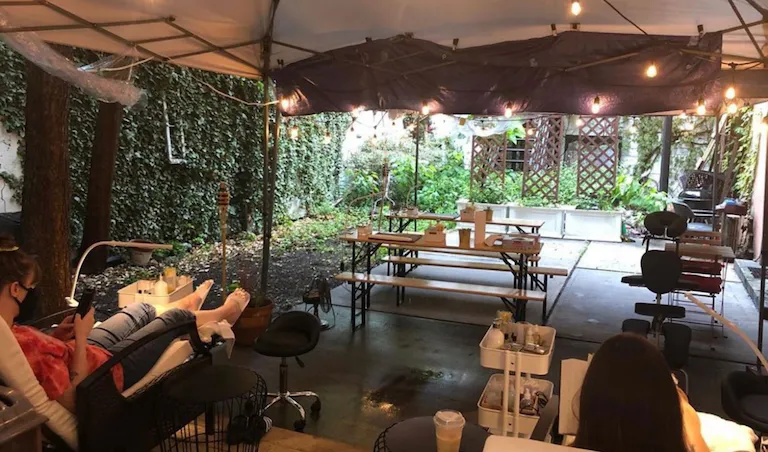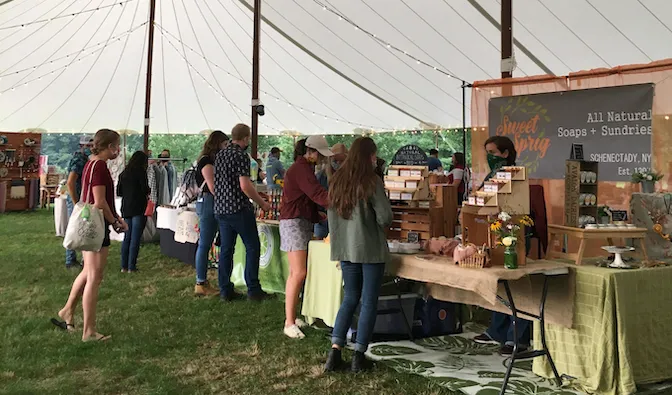Table of contents
Please note that this article is intended for educational purposes only and should not be deemed to be or used as legal advice. For guidance specific to your business, talk to a qualified professional.
As COVID-19 guidelines and reopening timelines continue to change, business owners are exploring a mix of strategies to stay open. Retail and service-based businesses in particular are getting creative about following safety precautions while maintaining in-person experiences.
We’ve explored how some UK businesses were able to boost sales by getting creative and moving online, from TODAY BREAD selling pantry staples in their community to 400° Pizzeria creating an online store to meet a new upswing in online ordering. This pandemic has put businesses around the world to the test, and many have responded with never before imagined ways to stay safe and successful during unprecedented times.
One way some businesses have seen success is by moving their operations outdoors. Outdoor shopping and selling comes with unique challenges, from finding enough space to revamping existing areas into usable spots.
We were able to speak with three U.S. business owners who worked through those challenges and successfully transitioned some or all of their operations outside.
When everything shut down
In March 2020, businesses across the world started closing due to growing concerns about the spread of COVID-19. And they had to pivot—quickly.
For Fort Orange General Store, an Albany, New York shop selling hand-picked home goods and gifts, local foot traffic drives a large portion of sales. To maintain the business, the team transitioned from in-store shipping and in-person sales to online services overnight, according to owner Schuyler Bull.
The move initially paid off for Bull. He was able to translate local support for Fort Orange into a booming online store.
“When we first announced our closure, our customer base supported us immediately with a rush of online orders,” Bull said. “So my store manager, Nicole, and I went to work rebuilding the online store from scratch while also buying all the materials needed to fulfill the orders that kept coming in.”
The online store was working. But eventually, online orders leveled off and Bull needed to find another way to drive sales, as customers were becoming more interested in offline shopping experiences.
Across other businesses, especially ones that offer services instead of products, having an online store can’t completely supplement the in-store experience. For salons, moving completely online isn’t feasible, beyond having websites where customers can directly book appointments.
Lili and Cata Nail Saloon, located in New York City, is owned by husband-and-wife team Lily and Jorge Rojas. They believe in using nontoxic, environmentally friendly products while creating a space for people to connect and unwind. Rojas had to shut his doors for weeks while he and his wife waited to find out how and when they could reopen the salon.
In Los Angeles, Summer Hours hair salon owner Amanda Riley faced the challenging task of opening her new business in June, just as cities were starting to open back up. Riley created Summer Hours as a space for independent stylists to boost their beauty industry knowledge while helping them build their personal brands. Rojas and Riley both needed a space where they could serve customers and maintain social distance, while still keeping the experience positive.
So when it came time for all three businesses to reopen in their respective states, they had one obvious tactic to try: set up shop outside.
Moving outside
When taking operations outdoors, many businesses have sectioned off areas of the pavement, a move that adds the challenge of complying with evolving local and state permits and outdoor shopping guidelines.
A simpler approach may be figuring out if there is any existing space you can turn into outdoor shopping or service space. You can also partner with local businesses or outdoor markets to use their space or find one you can use together. During the holidays, outdoor markets that allow shoppers to spread apart could be a useful approach to reach more customers.
Bull, Rojas, and Riley discovered that they needed to do what worked best for their existing locations and offerings.

The backyard salon at Lili and Cata’s Nail Saloon.
Creating an outdoor oasis
Rojas and Riley were both fortunate to have existing outdoor spaces. Rojas and his team decided to invest in turning Lili and Cata’s backyard into a “little oasis” for customers, allowing them to keep up their level of service even during social distancing.
“When we leased the space, we always knew we wanted to utilise the backyard as a fun space to get outdoor services,” Rojas said. “The pandemic obviously made the outdoor space a necessity as opposed to just a fun option.”
Riley wanted to create an outdoor space at Summer Hours that was enjoyable for both customers and her stylists. Rather than operating on pavements or in car parks, Riley created a private environment with “plants, cactuses, and cafe lights to set the vibe.”

A peek at Summer Hours’ renovated outdoor space.
All of those modifications cost money, so Riley said that they had to quickly apply for the Payroll Protection Program (PPP) and Economic Injury Disaster Loans (EIDL) to help with some of the overhead.
Taking to the streets
For sellers that don’t have their own outdoor shopping or service space, moving outdoors creates some new operational hurdles. Selling on the pavement means competing with pedestrian traffic, limited space, and city regulations. Business owners also need to be mindful of leaving enough space for passers-by with disabilities.
To get ahead of these outdoor shopping challenges, Bull borrowed a farmer’s market model, where one day a week he and his team bring Fort Orange General Store to the streets. These Saturday pop-up markets have been highly successful in driving foot traffic, according to Bull.
Bull also hosts a “completely socially distant” maker’s market at a local farm, taking advantage of existing outdoor retail space to attract customers. By partnering with a local farm that already has plenty of space, he saves money on overhead and time and is able to easily follow retail guidelines during COVID-19.
Following safety guidelines
Moving outside was just the first step to reopen. There were other tasks these business owners had to undertake to make their new spaces work.
Riley created a touch-free environment at her salon—from temperature checks and hand sanitising stations to contactless checkout using Square Terminal, right from the salon chair.
Bull went to great lengths to keep customers and employees compliant with local outdoor shopping guidelines as the only in-person makers’ market in their area this summer. “We had to ensure social distancing from start to finish,” Bull said.
“So we had many hands on deck ensuring we didn’t have more than 50 people in the event tent at any one time, vendor tables were set up at least ten feet apart, shoppers moved in one direction throughout the tent, and everyone received hand sanitiser when entering or exiting the tent. Not an easy feat by any means, but we pulled it off.”

Fort Orange General Store during an outdoor pop-up market.
Iterating is everything
The business owners we talked to all had to put in long hours to adapt to this new normal and comply with retail guidelines during COVID-19. But they also said that being flexible and having a positive attitude went a long way in making the process run smoothly.
Rojas advises other business owners to expect a period of trial and error until the outdoor shopping space works for your business. “Nothing is ever easy when you have to rush to get things done,” he said.
Riley recommends keeping your staff and customers up to date on changes to outdoor shopping guidelines, even if those changes happen overnight.
“Communicate often, empower your staff, and try anything,” she said. “If it isn’t working, drop it, and try something else.”
It also helps to look at the investment in an outdoor shopping space as a longer-term play while the pandemic continues and the holidays approach. For Bull, Fort Orange’s weekly pop-up markets have been a “fun opportunity” to connect with customers in new ways.
![]()












